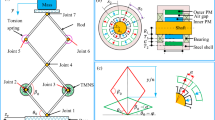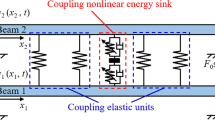Abstract
A novel resilient variable friction damper (RVFD) with a simple construction was proposed. To analyze the effects of loading rate on the stability and energy dissipation performance of the RVFD, two RVFDs were tested under different loading rates and the hysteretic behaviors of the compared with that of the traditional constant friction dampers. Then the peak force, energy dissipation behavior, uneven gap opening of the grooved outer plates (GOPs), and performance of the disc springs under different loading rates were studied. The results show that although no self-centering system was provided, only the RVFDs without a self-centering system still can exhibit stable self-centering performance and effective energy dissipation behaviors, especially with due to the using e of athe grooved steel plates with greater groove angle. When the loading rate is less than 10 mm/s, the peak forces of the RVFD slightly decrease with the increase in loading rates, while when the loading rate is greater than 10 mm/s, its effects could be neglected. The uneven gap opening of the GOPs influences the clamping forces of the disc springs in the bolts under different loading amplitudes. The disc springs in the RVFDs not only provide the increasing clamping forces for energy dissipation and the restoring forces for self-centering behavior, but also dissipate the energy, which accounts for about 10% of the total energy dissipation of the RVFD.















Similar content being viewed by others
References
Ajrab, J. J., Pekcan, G., & Mander, J. B. (2004). Rocking wall-frame structures with supplemental tendon systems. Journal of Structural Engineering, 130(6), 895–903.
Andalib, Z., Kafi, M. A., Kheyroddin, A., et al. (2014a). Seismic performance of off-centre braced frame with circular element in optimum place. International Journal of Steel Structures, 14(2), 293–304.
Andalib, Z., Kafi, M. A., Kheyroddin, A., et al. (2014b). Experimental investigation of the ductility and performance of steel rings constructed from plates. Journal of Constructional Steel Research, 103(1), 77–88.
Andalib, Z., Kafi, M. A., Kheyroddin, A., et al. (2018). Numerical evaluation of ductility and energy absorption of steel rings constructed from plates. Engineering Structures, 169, 94–106.
Bazzaz, M., Andalib, Z., Kafi, M. A., et al. (2015a). Evaluating the performance of OBS-CO in steel frames under monotonic load. Journal of Earthquakes and Structures, 8(3), 697–710.
Bazzaz, M., Andalib, Z., Kheyroddin, A., et al. (2015b). Numerical comparison of the seismic performance of steel rings in off-centre bracing system and diagonal bracing system. Journal of Steel and Composite Structures, 19(4), 917–937.
Bazzaz, M., Kheyroddin, A., Kafi, M. A., et al. (2012). Evaluation of the seismic performance of off-centre bracing system with ductile element in steel frames. Steel & Composite Structures, 12(5), 445–464.
Bruce, T. L., & Eatherton, M. R. (2016). Behavior of post-tensioning strand systems subjected to inelastic cyclic loading. Journal of Structural Engineering, 142(10), 04016067.
Chandrasekaran, S. (2016). Offshore structural engineering: Reliability and risk assessment. CRC Press.
Chandrasekaran, S. (2017). Dynamic analysis and design of ocean structures. Springer.
Chandrasekaran, S. (2019). Advanced steel design of structures. CRC Press.
Choi, E., Lee, J., & Youn, H. (2020). An experimental study on the performance of a damper fabricated by dual rubber springs. International Journal of Steel Structures, 20(6), 1891–1903.
Christopoulos, C., Tremblay, R., Kim, H. J., et al. (2008). Self-centering energy dissipative bracing system for the seismic resistance of structures: Development and validation. Journal of Structural Engineering, 134(1), 96–107.
Clayton, P. M., Tsai, C. Y., Berman, J. W., et al. (2015). Comparison of web plate numerical models for self-centering steel plate shear walls. Earthquake Engineering & Structural Dynamics, 44(12), 2093–2110.
Clayton, P. M., Winkley, T. B., Berman, J. W., et al. (2012). Experimental investigation of self-centering steel plate shear walls. Journal of Structural Engineering, 138(7), 952–960.
Dowden, D. M., & Bruneau, M. (2016). Dynamic shake-table testing and analytical investigation of self-centering steel plate shear walls. Journal of Structural Engineering, 142(10), 04016082.
Erochko, J., Christopoulos, C., Tremblay, R., et al. (2013). Shake table testing and numerical simulation of a self-centering energy dissipative braced frame. Earthquake Engineering & Structural Dynamics, 42(11), 1617–1635.
Hashemi, A., Masoudnia, R., & Quenneville, P. (2016). A numerical study of coupled timber walls with slip friction damping devices. Construction and Building Materials, 121(3), 373–385.
Hashemi, A., Zarnani, P., Masoudnia, R., et al. (2017). Seismic resistant rocking coupled walls with innovative Resilient Slip Friction (RSF) joints. Journal of Constructional Steel Research, 129(4), 215–226.
Huang, L., Zhou, Z., Clayton, P. M., et al. (2019). Experimental investigation of friction-damped self-centering prestressed concrete beam-column connections with hidden corbels. Journal of Structural Engineering, 146(3), 04019228.
Huang, L., Zhou, Z., & Clayton, P. M. (2021). Experimental and numerical study of unbonded post-tensioned precast concrete connections with controllable post-decompression stiffness. The Structural Design of Tall and Special Buildings, 30(7), e1847.
Huang, X., Eatherton, M. R., & Zhou, Z. (2020). Initial stiffness of self-centering systems and application to self-centering-beam moment-frames. Engineering Structures, 203, 109890.
Huang, X., & Wang, Y. (2021). Development and modelling of new friction damped self-centring link for coupled wall systems. Engineering Structures, 239, 112365.
Jeong, K., Choi, E., Back, S.-Y., et al. (2016). Smart damper using sliding friction of aramid brake lining and self-centering of rubber springs. International Journal of Steel Structures, 16(4), 1239–1250.
Li, H., Liu, M., & Fu, X. (2018). An innovative re-centering SMA-lead damper and its application to steel frame structures. Smart Materials and Structures, 27(7), 075029.
Li, Y., Liu, Y., & Chen, Z. (2020). Seismic response assessment of a hybrid coupled wall structure with novel self-centering steel truss coupling beams. Bulletin of Earthquake Engineering, 18, 1–24.
Li, Y., Liu, Y., & Meng, S. (2019). Seismic performance evaluation of coupled wall system with novel replaceable steel truss coupling beams. Advances in Structural Engineering, 22(6), 1284–1296.
Liu, L., Wu, B., Li, W., et al. (2012). Cyclic tests of novel self-centering buckling-restrained brace. Journal of Southeast University (natural Science Edition), 42(3), 526–530. (in Chinese).
Lu, X., Zhou, Y., Chen, C., et al. (2014). Research progress on innovative earthquake-resilient structural systems. Earthquake Engineering and Engineering Dynamics, 34(4), 130–139. (in Chinese).
Manjoine, M. J. (1944). Influence of rate of strain and temperature on yield stress of mild steel. Journal of Applied Mechanics, 66(4), A211–A218.
McCormick, J., Aburano, H., Ikenaga, M., et al. (2008). Permissible residual deformation levels for building structures considering both safety and human elements. In Proceedings of the 14th World Conference of Earthquake Engineering, Beijing, China. Paper. 2008(5), 71.
Qiu, C., & Zhu, S. (2017a). Shake table test and numerical study of self-centering steel frame with SMA braces. Earthquake Engineering & Structural Dynamics, 46(1), 117–137.
Qiu, C., & Zhu, S. (2017b). Performance-based seismic design of self-centering steel frames with SMA-based braces. Engineering Structures, 130(1), 67–82.
Qu, Z., Xie, J., Cao, Y., et al. (2020). Effects of strain rate on the hysteretic behavior of buckling-restrained braces. Journal of Structural Engineering, 146(1), 06019003.
Sharbati, R., Hayati, Y., & Hadianfard, M. (2019). Numerical investigation on the cyclic behavior of post-tensioned steel moment connections with bolted angles. International Journal of Steel Structures, 19(6), 1840–1853.
Song, L. L., Guo, T., & Chen, C. (2014). Experimental and numerical study of a self-centering prestressed concrete moment resisting frame connection with bolted web friction devices. Earthquake Engineering & Structural Dynamics, 43(4), 529–545.
Tremblay, R., Bolduc, P., Neville, R., et al. (2006). Seismic testing and performance of buckling-restrained bracing systems. Canadian Journal of Civil Engineering, 33(2), 183–198.
Wang, Y., Zeng, B., Zhou, Z., et al. (2021a). Hysteretic and seismic performance of dual self-centering variable friction damper braces. Soil Dynamics and Earthquake Engineering, 147(1), 106774.
Wang, Y., Zhou, Z., Xie, Q., et al. (2020). Theoretical analysis and experimental investigation of hysteretic performance of self-centering variable friction damper braces. Engineering Structures, 217(1), 1–13.
Wang, Y., Zhou, Z., Zhang, L., et al. (2021b). Quantification of higher mode effects of steel frame and control method using dual self-centering variable friction damper brace. Engineering Structures, 240(1), 112368.
Xu, L., Fan, X., & Li, Z. (2017). Cyclic behavior and failure mechanism of self-centering energy dissipation braces with pre-pressed combination disc springs. Earthquake Engineering & Structural Dynamics, 46(7), 1065–1080.
Xu, L., Xie, X., & Li, Z. (2018). Development and experimental study of a self-centering variable damping energy dissipation brace. Engineering Structures, 160(1), 270–280.
Zhang, A., Quan, Q., Zhan, X., et al. (2017). Force mechanism analysis of fabricated friction dissipation re-centering brace with zero initial cable force. Journal of Southeast University (natural Science Edition), 47(1), 142–149. (in Chinese).
Zhang, X., Hao, H., Shi, Y., et al. (2016). Static and dynamic material properties of CFRP/epoxy laminates. Construction and Building Materials, 114(1), 638–649.
Acknowledgements
The authors would like to acknowledge financial supports from “National Key Research and Development Program of China (Grant No. 2018YFC0705700)”, “National Natural Science Foundation of China (Grant No. 51878150)”, and “Postgraduate Research & Practice Innovation Program of Jiangsu Province (KYCX21_0115)”. These supports are gratefully acknowledged.
Author information
Authors and Affiliations
Corresponding author
Ethics declarations
Conflict of interest
The authors declare that they have no known competing financial interests or personal relationships that could have appeared to influence the work reported in this paper.
Additional information
Publisher's Note
Springer Nature remains neutral with regard to jurisdictional claims in published maps and institutional affiliations.
Rights and permissions
About this article
Cite this article
Wang, Y., Zhou, Z. & Huang, L. Effects of Loading Rates on the Hysteretic Response of Resilient Variable Friction Dampers. Int J Steel Struct 21, 1550–1563 (2021). https://doi.org/10.1007/s13296-021-00519-5
Received:
Accepted:
Published:
Issue Date:
DOI: https://doi.org/10.1007/s13296-021-00519-5




